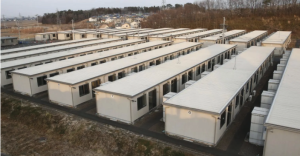Prefabricated houses a big help in post-disaster reconstruction
After the ravages of natural disasters, the ruins often carry endless sorrow and hope for reconstruction. In the face of the devastation, how to quickly and efficiently restore the living order of the residents has become the top priority of the post-disaster reconstruction work. In this context, prefabricated houses, with their unique advantages, play an irreplaceable role in post-disaster reconstruction and become the “gas pedal” for rebuilding homes.

Prefabricated houses, as the name suggests, are produced in factories according to uniform standards and well-designed drawings, and then the components are transported to the site to be assembled into houses. This type of construction method has shown many advantages in post-disaster reconstruction.
First, prefabricated houses greatly shorten the construction period. The traditional construction method requires on-site construction, which is affected by weather, material supply and other factors, and the construction period is long. On the other hand, prefabricated houses can be mass-produced in factories without weather restrictions, and can be quickly assembled once on-site conditions are available, which greatly shortens the time residents are displaced outside and speeds up the pace of returning to normal life.
Secondly, prefabricated houses have a high degree of quality control. Factory production means that each process can be strictly quality control, reducing human error and on-site construction of uncontrollable factors, thus improving the overall quality of housing. Prefabricated houses undergo strict quality control in the factory, and each process follows established standards and procedures, ensuring the precision and strength of the components.
In addition, prefabricated houses are mostly made of lightweight and high-strength materials with good seismic and wind resistance properties, which can to a certain extent withstand the re-attack of natural disasters. This quality and reliability provides a safe and stable living environment for the people affected by the disaster, enabling them to rediscover their sense of belonging after the disaster. This is particularly important for post-disaster reconstruction, as sturdy and durable housing is the cornerstone for residents to rebuild their lives.
Furthermore, prefabricated houses are flexible and movable. In post-disaster reconstruction, it is often necessary to adjust the construction program according to the actual situation, and the modular design of prefabricated houses makes it relatively easy to adjust. At the same time, for some temporary resettlement sites, prefabricated houses can be quickly erected and dismantled, which facilitates subsequent land use and planning adjustments.
In addition, prefabricated houses are also in line with the concept of green building. With the enhancement of environmental awareness, prefabricated houses pay more attention to energy saving and emission reduction in the production process and use environmentally friendly materials, which reduces the consumption of natural resources and environmental damage. Promoting prefabricated houses in post-disaster reconstruction not only helps to quickly restore residents' lives, but also promotes sustainable development.
The widespread use of prefabricated houses in post-disaster reconstruction also promotes the active participation of all sectors of society. The government, enterprises, non-profit organizations and individual volunteers work together to provide necessary support and assistance to the affected people. The rapid construction capacity of prefabricated houses enables more social resources to be quickly put into the post-disaster reconstruction work, forming a strong synergy. This atmosphere of social participation not only accelerates the reconstruction process, but also strengthens the cohesion and centripetal force of the affected people, and injects a strong impetus for building a better home together.
To summarize, prefabricated houses play an irreplaceable role in post-disaster reconstruction. With its fast, efficient and high quality, it provides a warm shelter for the affected people and accelerates the process of rebuilding their homes. In the future, with the continuous progress of technology and the continuous support of policies, prefabricated houses are expected to be applied in more fields and bring more benefits to human society.
Related News:https://new.qq.com/rain/a/20240712A0AJXI00
Post time: 09-02-2024







